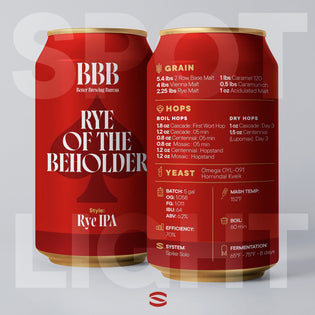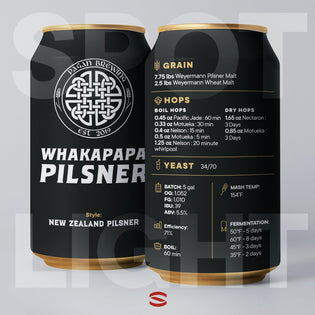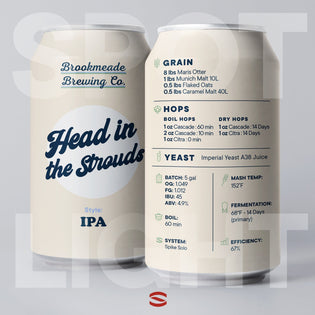
The Brewer: Sam Gilchrist
My name is Sam Gilchrist. I live in Saskatoon, Saskatchewan, I hold a Ph.D. in pharmaceutical sciences, and I adore Spike.
My Flex+ fermenters are workhorses for fermentation, the Solo+ is a 240V BEAST, and it really is only a matter of time before I end up with the Spike Nano or three-vessel system… I might need to convince my wife on this though.

The jump into home brewing, like many others, was driven by the global COVID pandemic. The pandemic was a reminder that nothing in this world is certain, and there is no need to hold off on fulfilling dreams. Now, I’m able to create very good beer (better than most commercial samples in my not-so-humble opinion) and am fortunate to be able to share these creations with friends.
I call my brewing space Old Goat Brewing Company, as my wife calls me an old goat all the time due to my stubbornness. My tagline is “Misery Loves Company."
The Beer: American Wheat
The colour on this wheat beer is stunning. I call this recipe Rubus Ridonkulous because “Rubus” is a diverse group of plants in the rose family.
Of these, Rubus idaeus is the red raspberry we all love. I chose the name because of the intense red hue created by transferring fermented beer onto raspberries for 24 hours, as well as the very fruit-forward taste. Ridonkulous, indeed!

For grains, I chose a very basic wheat recipe of 50:50 pale malt: wheat malt with minimal specialty grains, which would allow me to highlight the fruit; a blank canvas wheat recipe to highlight adjuncts.
The Recipe: Rubus Ridonkulous

INGREDIENTS
GRAIN
- 7 lbs Pale malt
- 6.5 lbs White Wheat
- 0.6 lbs Carapils
HOPS
- 0.75 oz Centennial (AA 9.9%): 0:60 min
- 1 oz Centennial (AA 9.9%) at flame out: 0 min
- 0.5 oz Saaz (AA 3.2%) at flame out: 0 min
ADJUNCTS
- 1 lb/gallon pasteurized frozen raspberries
YEAST
- Wyeast Labs 1010 (American Wheat Ale)

INSTRUCTIONS
BATCH SIZE: 5 gal
OG: 1.049
FG: 1.006
IBU: 23
ABV: 5.6%
EFFICIENCY: 70%
MASH TEMP: 152 ºF
BOIL: 60 min
FERMENTATION: 65ºF - 10 days
SYSTEM: Solo
Recipe Breakdown
- For a 5-gallon batch, I used 5 lbs of frozen raspberries.
- The raspberries were vacuum sealed and subsequently pasteurized by holding at 160F for 30 minutes using a sous vide set up. They were allowed to cool until use.
- The beer was transferred to either a sanitized keg or secondary fermenter (when I got my second Flex+) containing the raspberries in a nylon bag that had been boiled for 10 minutes to sterilize.
- The berries were allowed to hang out until I achieved the ideal taste, typically 2-3 days, where they lost a lot of their colour. It was so cool!
Spike Summarizes: Wheat Beer
What is a Wheat Beer?
Wheat beer, as its name suggests, is a type of beer made from a large proportion of wheat. It's a broad category with a variety of styles, each offering unique flavors and characteristics.
What is the history of a Wheat Beer?
Wheat beers have a long history, dating back to ancient times. However, their resurgence in modern brewing can be traced back to Germany and Belgium, where styles like Weissbier and Witbier respectively originated.
What makes Wheat Beer different from other beers?
Unlike other beers, which primarily rely on barley, wheat beers use a large percentage of wheat in their grain mix - usually between 30% and 70%. This differentiates them in taste, appearance, and texture.
Wheat beers often have a distinctive cloudy appearance due to the proteins and yeast suspended in the beer, creating a haze when served.
What does a Wheat Beer taste like?
Wheat beers are known for their light, refreshing taste. They often exhibit a fruity and spicy character, with flavors such as banana, clove, and vanilla being quite common. Wheat beers also tend to have a silky mouthfeel due to the high protein content of wheat.
How is Wheat Beer made?
The brewing process of wheat beer isn't dissimilar to other beer types. The key difference lies in the grain bill, where a substantial amount of wheat is used. Additionally, special strains of yeast are often employed, imparting unique flavor profiles.
What are the essential ingredients in a Wheat Beer?
Four main ingredients make up a wheat beer: water, wheat, hops, and yeast. The wheat provides the base, the hops balance sweetness with bitterness, and the yeast contributes to flavor and alcohol content.
What foods go best with a Wheat Beer?
Wheat beers go well with light and flavorful dishes. They pair nicely with salads, seafood, sushi, and a variety of cheeses. Their refreshing character also makes them a fantastic accompaniment to spicy foods.
Is Wheat Beer a year-round beer?
Yes, wheat beer can be enjoyed year-round. However, its light, refreshing character makes it a popular choice during the warmer months of spring and summer.
How strong is a typical Wheat Beer?
Typically, wheat beers are moderate in alcohol content, ranging from 4% to 5.5% ABV. However, some styles, like Weizenbock, can reach up to 7% or more.
Are there different types of Wheat Beer?
Yes, there are several different styles of wheat beer, including German Weizenbier, Belgian Witbier, American Wheat, and the more potent Weizenbock, each with its unique characteristics.
What's the correct temperature for serving Wheat Beer?
Wheat beers are best served slightly chilled, typically between 45-50 degrees Fahrenheit. This temperature allows their unique flavors and refreshing character to shine.
What are some popular brands of Wheat Beer?
Some popular wheat beer brands include Weihenstephaner, Schneider Weisse, and Paulaner from Germany, Hoegaarden from Belgium, and Blue Moon and Bell's Oberon from the United States.
Why does Wheat Beer have a golden color?
The golden color of wheat beers is due to the grains used in brewing. The wheat contributes a light color, while the specific yeast strains can add a slight cloudiness, giving the beer a distinctive pale, often golden hue.
How does the brewing process affect Wheat Beer's flavor?
The choice of yeast, fermentation temperature, and the proportion of wheat used in brewing can all significantly impact the flavor of a wheat beer. Brewers have immense creative freedom in tweaking these variables to create unique taste profiles.
Are Wheat Beers more bitter than other beers?
Typically, wheat beers are not as bitter as other beer styles, like IPAs. They have a low to medium bitterness level, as the flavor profile leans more towards fruity and spicy notes.
Why is Wheat Beer often served in a specific type of glass?
Wheat beers are typically served in a tall, slender glass known as a Weizen glass. This glass's design showcases the beer's color, retains the foam head, and allows for the aromas to be appreciated more fully.
Is Wheat Beer good for beginners?
Absolutely! Wheat beers, with their light and refreshing flavor profiles, are a great entry point for those new to beer. Their mild and versatile taste makes them an excellent choice for beginners.
Where can I buy the best Wheat Beers?
Most local liquor stores will carry a selection of wheat beers. For a more extensive variety, check out craft beer-specific stores, online beer marketplaces, or direct from breweries.
Are there any unique facts about Wheat Beer?
Wheat Beer Trivia
You bet! Here are a few fun facts:
- Ancient Beginnings: Evidence of brewing with wheat has been found in ancient Sumerian and Egyptian civilizations. This makes wheat beer one of the oldest known types of beer!
- Royal Monopoly: In the Middle Ages, in certain parts of Europe, only royalty could brew wheat beer. This monopoly was eventually broken, giving rise to the popularity of the beverage.
- The Yeast Secret: In traditional brewing, the yeast strains used for wheat beers were often kept secret, passed down through generations.
- Garnishing Tradition: In many places, it's common to garnish a wheat beer with a slice of lemon or orange. This accentuates the beer's citrus notes.
How does German Wheat Beer differ from Belgian Wheat Beer?
While both styles use a substantial amount of wheat, the flavor profiles and brewing methods differ.
German Wheat Beer or "Weissbier" is known for its distinct banana and clove notes, which come from the specific yeast strains used. German purity laws also require wheat beers to contain at least 50% wheat in the grain bill.
On the other hand, Belgian Wheat Beer or "Witbier" typically features coriander and orange peel, giving it a zesty, fruity character. Belgian brewers often use unmalted wheat and sometimes oats, lending a creamy texture to the beer.
How is Wheat Beer stored?
To ensure the best quality and flavor, wheat beer should be stored upright in a cool, dark place. This prevents oxidation and spoilage caused by heat and light.
Is Wheat Beer vegan?
Most wheat beers are indeed vegan, as they're made from water, grains (wheat and barley), hops, and yeast. However, some breweries might use animal-derived products in the brewing process (like isinglass for clarification), so it's best to check with the specific brewery if you're unsure.
How does Wheat Beer pair with desserts?
Wheat beers pair exceptionally well with many desserts due to their often fruity and spicy notes. They can complement fruit-based desserts like tarts or pies, cream-filled pastries, and even ice cream. A raspberry tart or a creamy crème brûlée with a glass of wheat beer would make for a delightful treat.
Can I brew Wheat Beer at home?
Absolutely, brewing wheat beer at home can be a rewarding experience! All you need are the basic home brewing equipment and ingredients, including malted wheat, hops, yeast, and water. Remember, the unique flavors of wheat beer are largely influenced by the yeast strain, so be sure to select the right one for the style you want to brew.
What does ABV mean in Wheat Beer?
ABV stands for Alcohol By Volume, a standard measure used worldwide to quantify the amount of alcohol (ethanol) contained in an alcoholic beverage. It represents what portion of the total volume of liquid is alcohol. In wheat beers, the ABV usually ranges from 4% to 5.5%, although certain styles like Weizenbock can have higher ABVs.
How is Wheat Beer served?
Wheat beer is typically served in a tall, slender glass, often called a Weizen glass. This glass shape helps maintain the beer's frothy head, releases the beer's aroma, and showcases its color. A proper pour involves tilting the glass and pouring slowly to prevent over-foaming. It's also traditional to swirl the last bit of beer in the bottle to collect the yeast sediment, which is then poured into the glass, enhancing the beer's flavor and appearance.
Is Wheat Beer gluten-free?
As wheat beer is brewed with wheat, it naturally contains gluten. Therefore, it's not suitable for people with celiac disease or those following a gluten-free diet. However, some breweries do offer gluten-free or gluten-reduced beers made using specific enzymes or alternative grain sources.
Why do some Wheat Beers have a banana flavor?
The banana flavor commonly associated with some wheat beers, especially German Weissbier, is due to a specific compound called isoamyl acetate. This compound is produced by the yeast during fermentation and imparts a fruity banana-like aroma and flavor to the beer.
Is Wheat Beer the same as White Beer?
While the terms are often used interchangeably, they refer to different things. "Wheat Beer" is a broad category of beers brewed with a substantial amount of wheat. "White Beer" is a literal translation of "Witbier," a type of Belgian wheat beer. The term "white" refers to the beer's pale, often cloudy appearance.
What's the best Wheat Beer for a beer tasting party?
The best wheat beer for a tasting party would be one that showcases the unique characteristics of the style. A German Hefeweizen like Weihenstephaner Hefeweissbier or an American Wheat Beer like Bell's Oberon Ale would be excellent choices. For a Belgian touch, try Hoegaarden's Witbier.
How has Wheat Beer evolved over the years?
Wheat beer has evolved significantly over time, with its roots dating back to ancient civilizations. It saw a decline in popularity during the Middle Ages but was revived in Germany and Belgium, where it began to take the form we recognize today. Over the years, brewers across the world have been experimenting with the style, leading to the creation of various sub-styles and interpretations, like the American Wheat Beer and the fruit-infused variants.
What is the shelf-life of Wheat Beer?
Wheat beers are generally meant to be consumed fresh and typically have a shelf-life of 6 to 9 months. However, the exact shelf-life can vary based on the specific style and brewing process. It is always recommended to check the "best before" date on the bottle or can.
Can Wheat Beer be aged?
While some beer styles like stouts and barley wines improve with age, wheat beers are generally not suitable for aging. They are designed to be enjoyed fresh, as aging may lead to a decline in their distinct flavor profiles and overall freshness.
What are some award-winning Wheat Beers?
Some wheat beers have been recognized in prestigious beer competitions. For instance, the "Weihenstephaner Hefeweissbier" has received multiple awards at the World Beer Awards. The "Allagash White," a Belgian-style wheat beer, has been honored at the Great American Beer Festival.
How does the color of Wheat Beer affect its taste?
The color of a wheat beer, which can range from pale straw to deep amber, comes from the type of malt used in brewing. While the color itself doesn't affect taste, it is indicative of the malt's roast level, which does influence the beer's flavor. Lighter wheat beers tend to be crisp and refreshing, while darker ones may have hints of caramel or toasted flavors.
How is the alcohol in Wheat Beer produced?
The alcohol in wheat beer, like all beers, is produced during fermentation. This process begins when yeast is added to the brew, consuming the sugars derived from the malted grains and converting them into alcohol and carbon dioxide. The specific yeast strain and fermentation temperature play a vital role in determining the beer's final alcohol content and flavor profile.
Why do some Wheat Beers taste sour?
Some wheat beers taste sour due to a unique fermentation process involving bacteria such as Lactobacillus and Pediococcus, which produce lactic acid. This process is common in styles like Berliner Weisse and Gose, resulting in a tart, sour taste.





